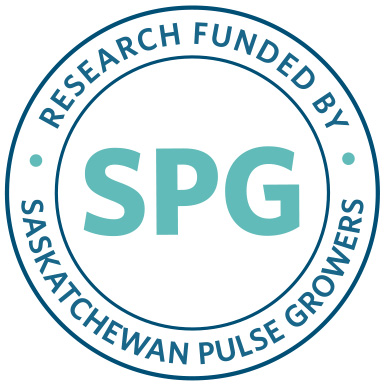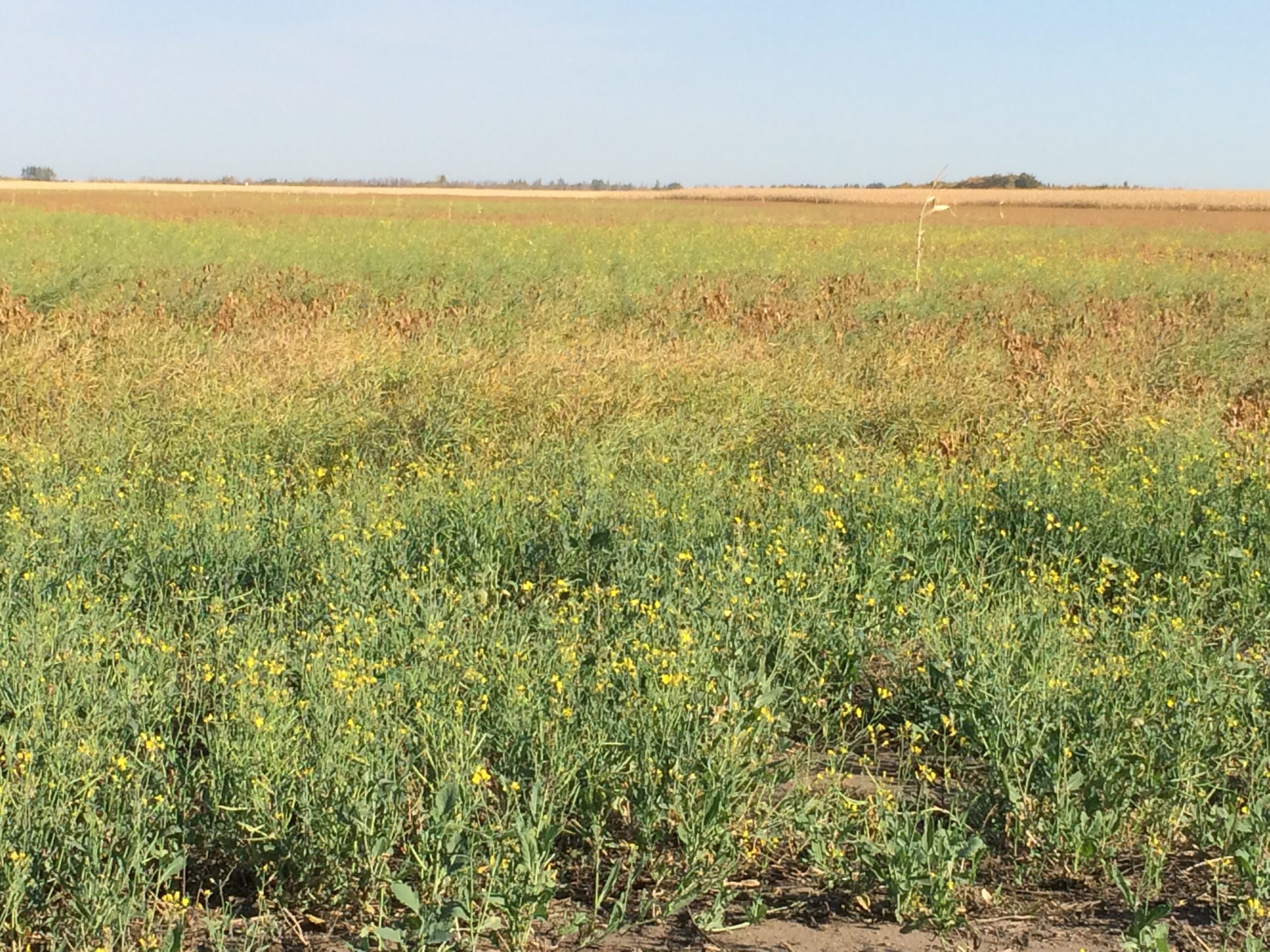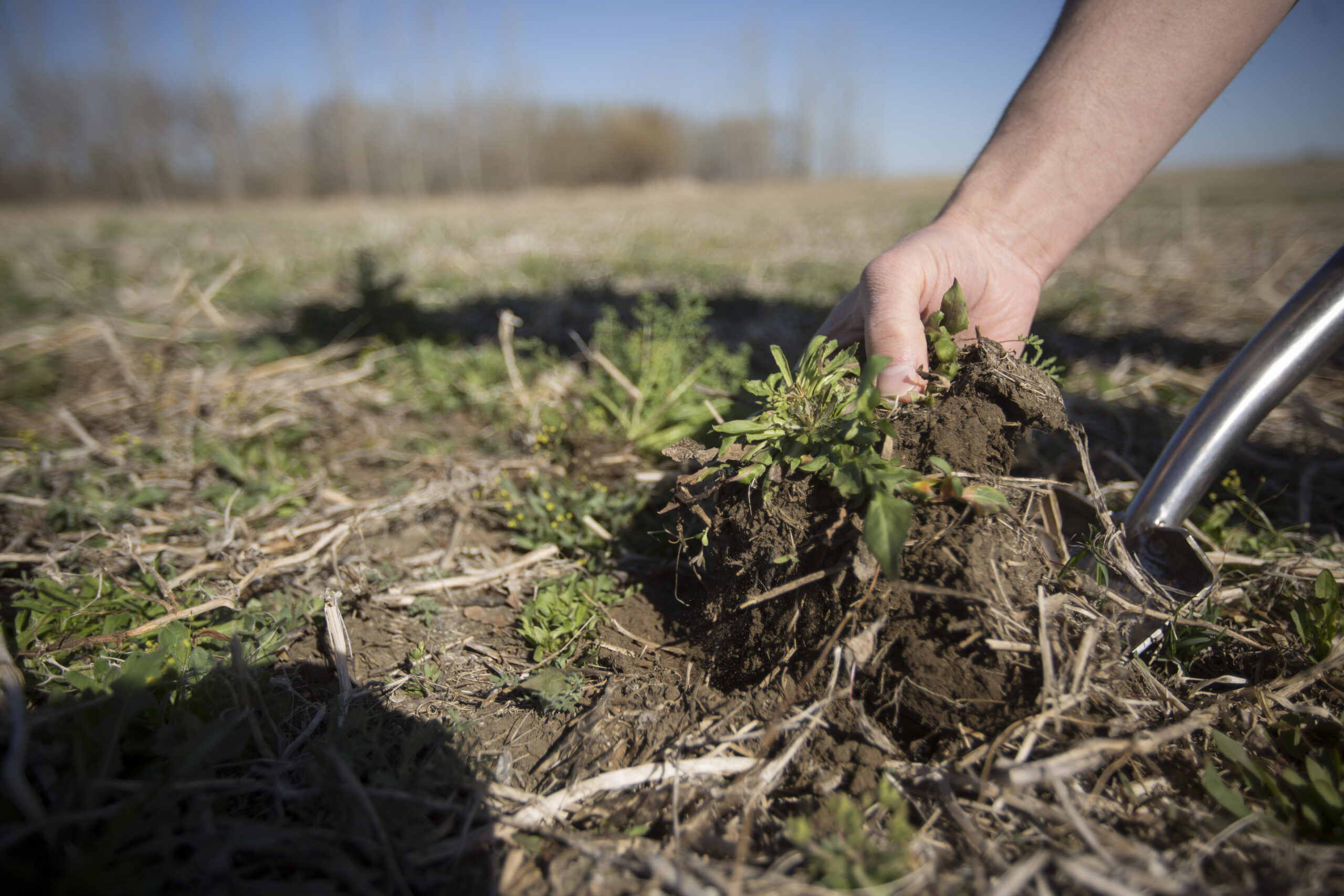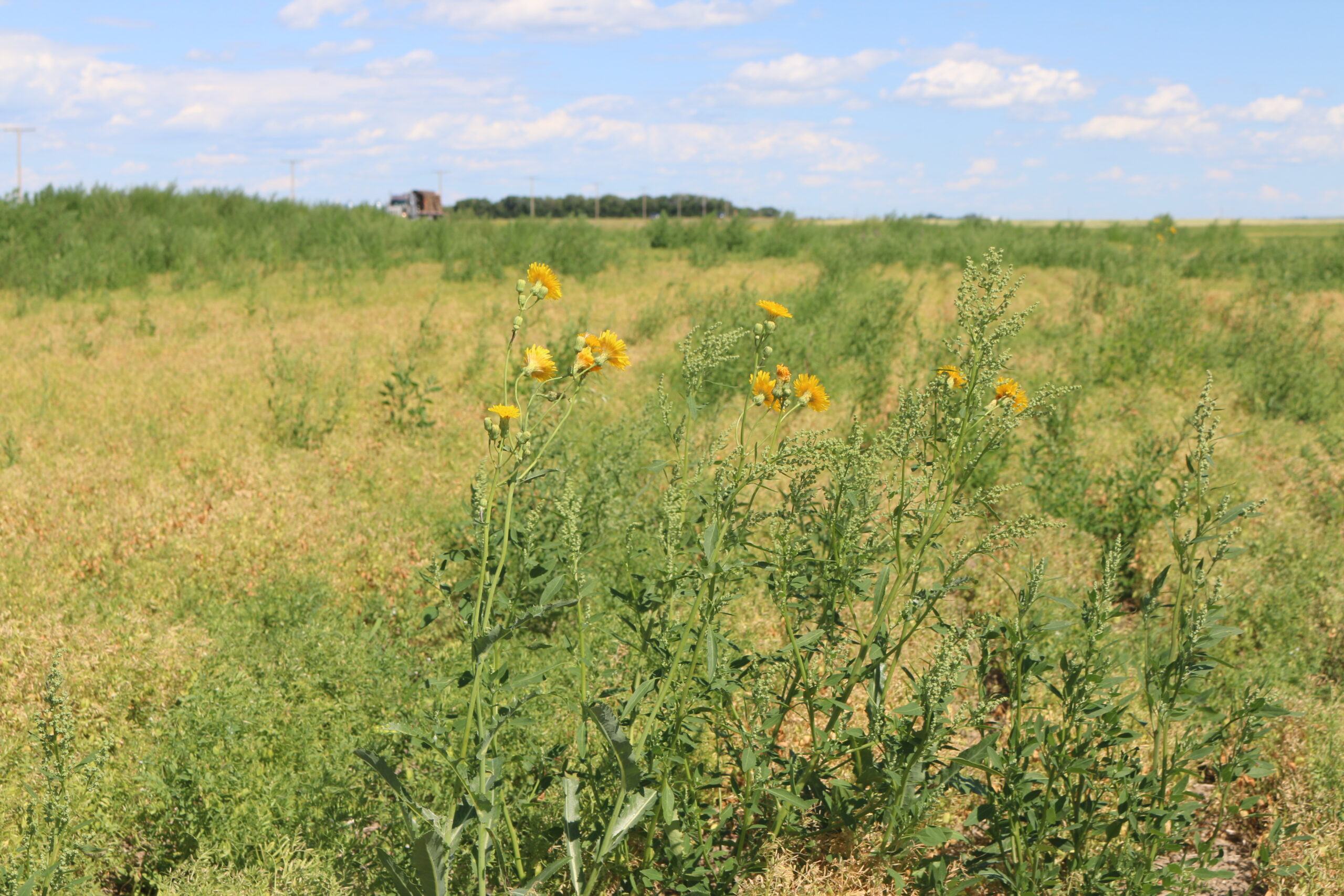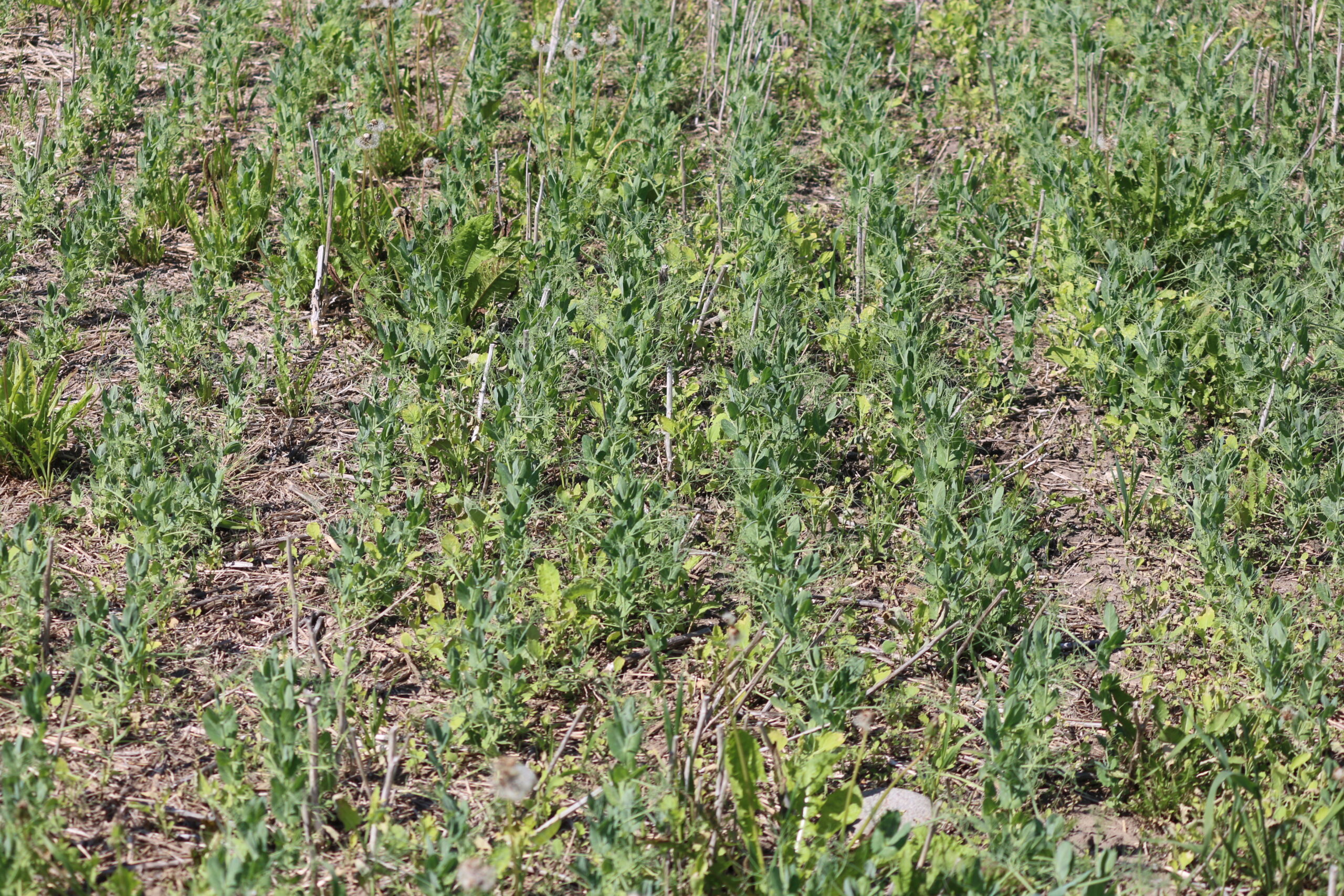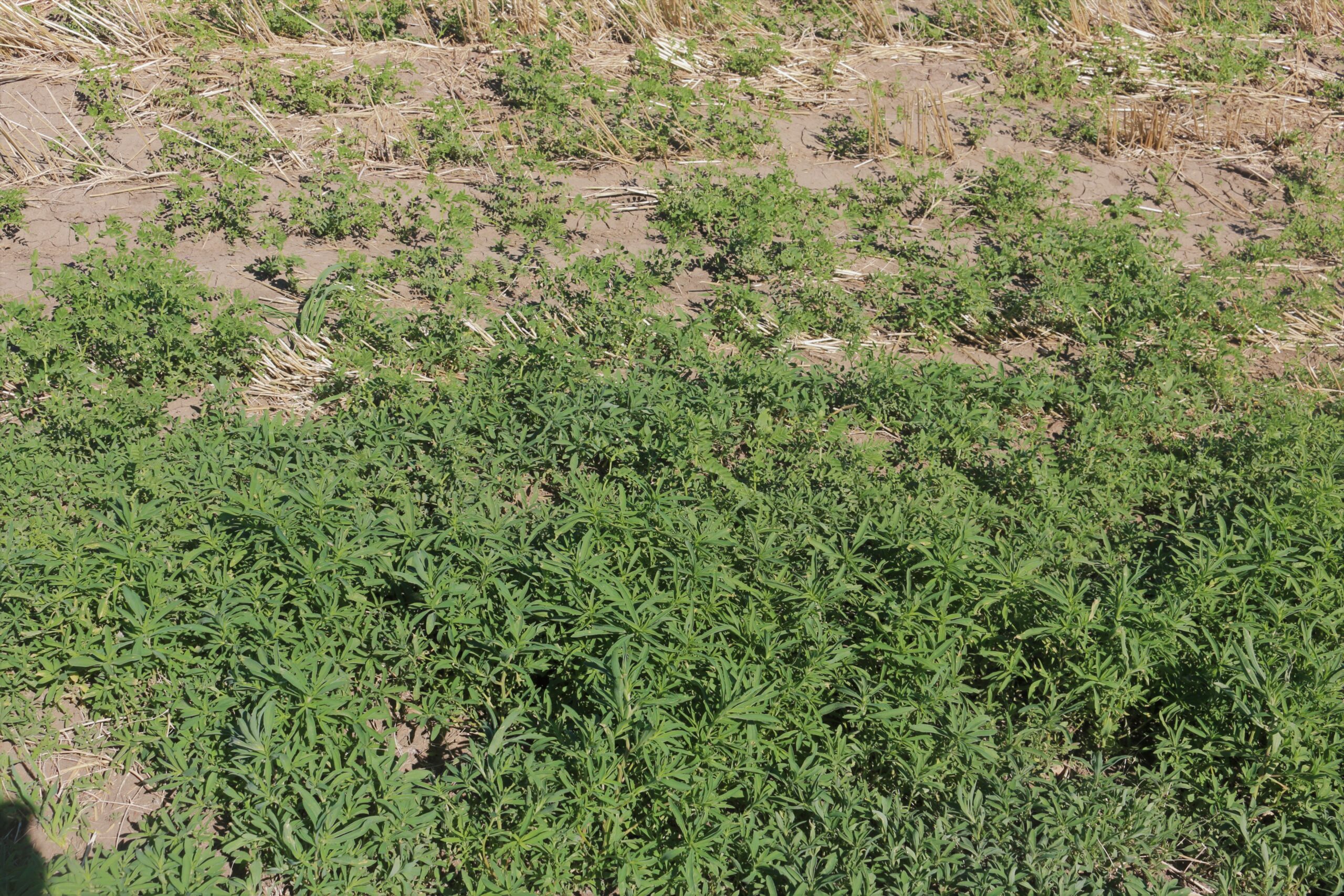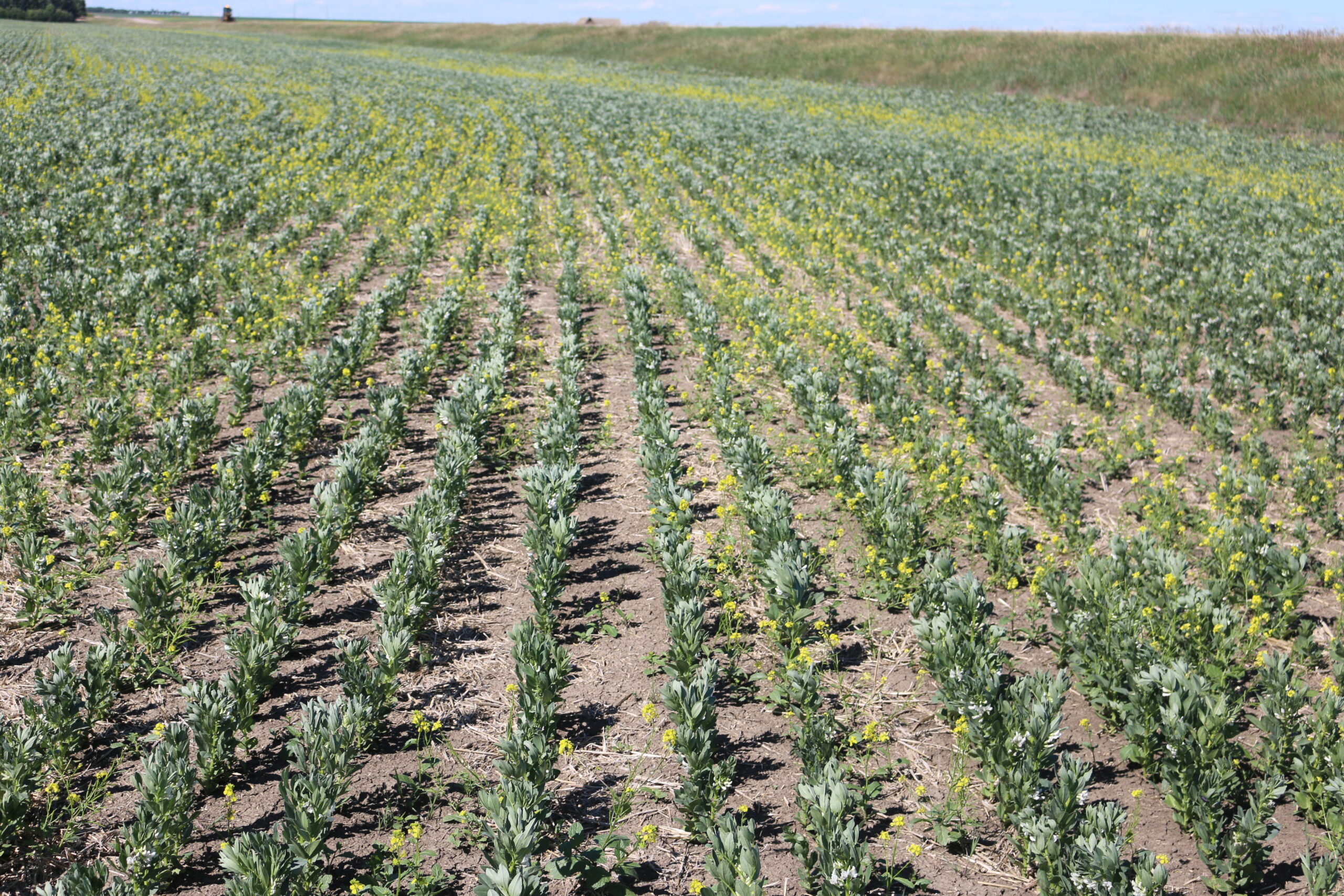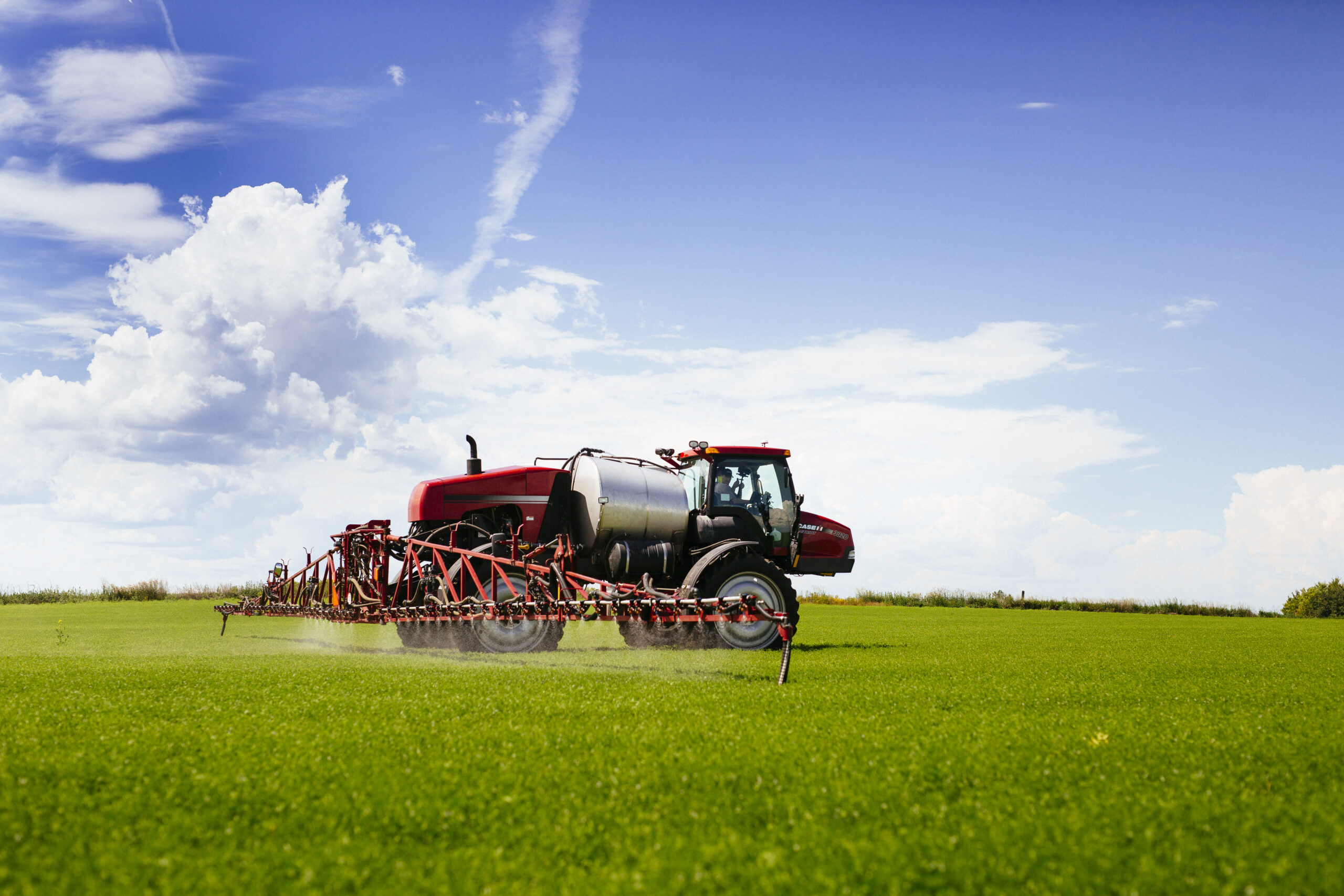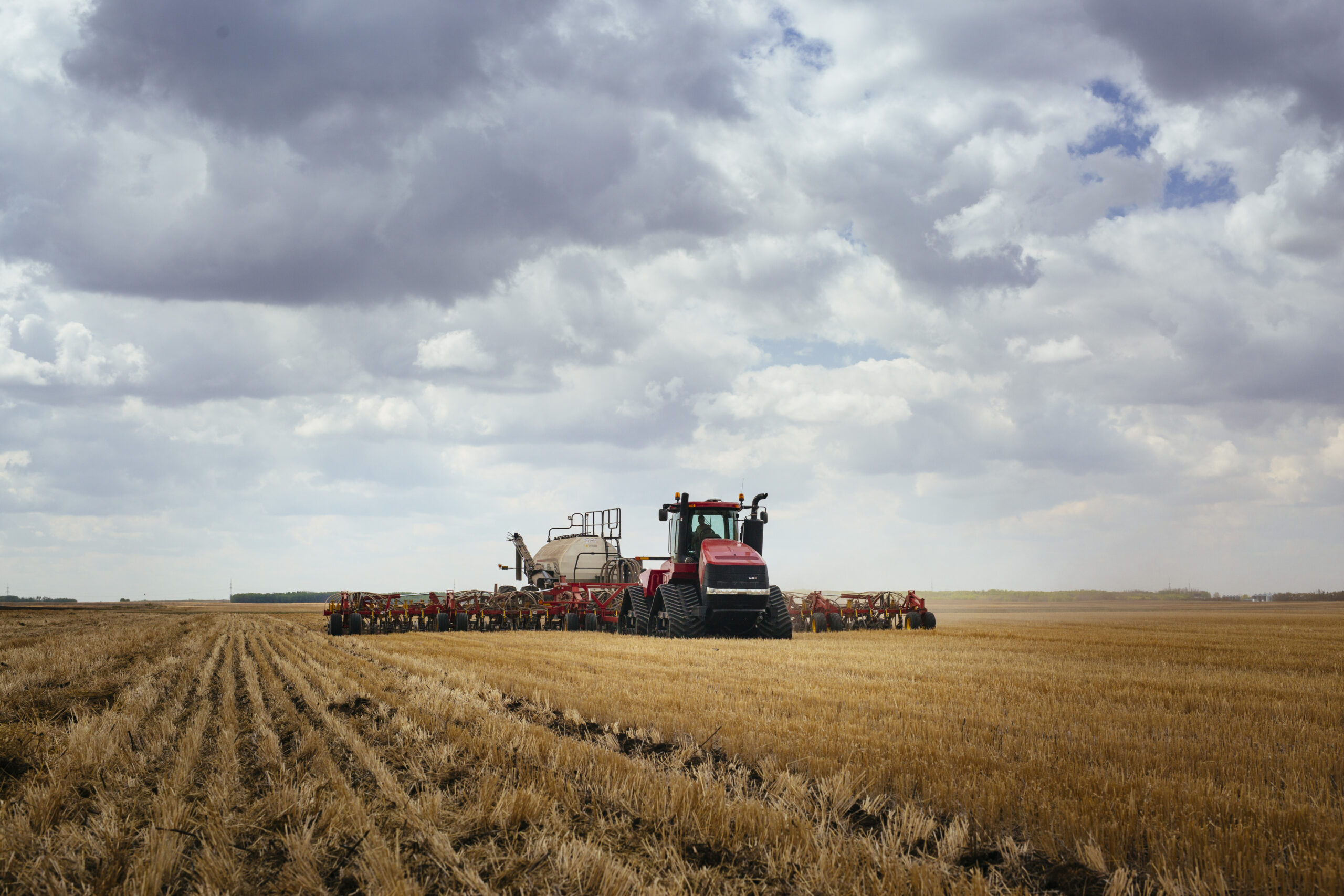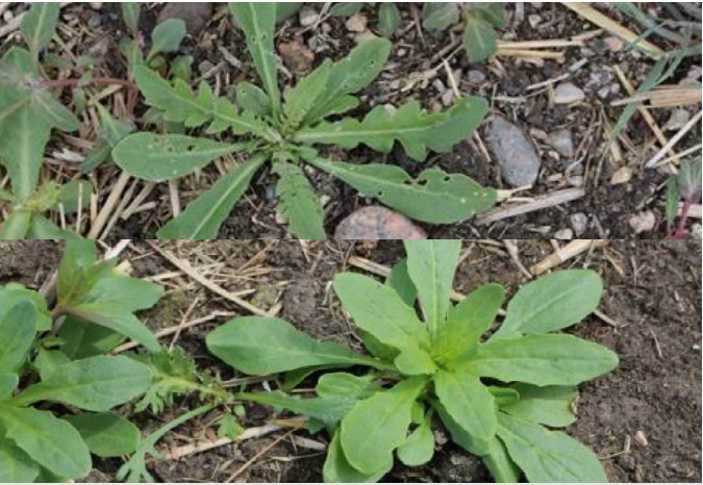Contributing Researchers: Dr. Chris Willenborg, Sid Darras, Eric Johnson, and Dr. Dilshan Benaragama
Introduction
A key weed concern for soybeans in Saskatchewan is volunteer glyphosate-resistant (GR) canola, as most growers use GR soybean varieties and employ glyphosate as the main herbicide for weed control. Soybeans are less competitive than canola, thus volunteer canola infestations can cause serious yield loss. For soybeans to be successful on the prairies, research is needed to develop effective strategies to manage volunteer canola. Potential volunteer GR canola management practices include the use of pre- and post-emergent herbicides, earlier seeding, and narrow row spacing. Research on these management practices in isolation has already been conducted, however the combined effect of these management practices on Saskatchewan soybean systems has not yet been investigated. To fill this research gap, Saskatchewan Pulse Growers funded a study from 2016 to 2020 that combined seeding date, row spacing, and pre- and post-emergent herbicides to determine if the combination of these management factors resulted in additive or synergistic effects for controlling volunteer GR canola.
Key Findings and Recommendations
- Use of a pre-emergent herbicide such as Heat® that has residual volunteer canola control along with an in-crop herbicide such as Viper® is recommended for best control of volunteer GR canola and maximized yield potential in glyphosate-resistant soybeans.
- Use of pre-emergent saflufenacil (Heat®) along with post- emergent imazamox and bentazon (Viper®) produced similar weed control and yield results to Viper® alone, with slight weed control improvement at one of six site-years and a yield benefit at two of six site-years.
- Use of Heat® pre-emergent alone was not an effective method of weed control, with similar weed biomass to the treatment with no additional herbicide at four of six site-years and higher canola weed seed production than Viper® or Heat® + Viper® at five of six site-years. Yield with Heat® alone was lower than Heat® + Viper® together at four of six site-years.
- Row spacing and seeding timing had less impact on weed control than the herbicide treatments. In the treatment with no additional herbicide, weed biomass was lower with late seeding and wide row spacing than early seeding and narrow row spacing. As well, in the Heat® only treatment, weed seed production was lower at the later seeding date.
- As with weed control, soybean biomass and yield were less influenced by cultural weed control practices versus chemical weed control practices. Earlier seeding date did produce higher crop biomass, however, neither row spacing nor seeding timing impacted yield.
- With the use of Viper® or Viper® + Heat®, the seeding date may not influence weed control or yield. When no herbicide is used or when Heat® only is applied, a later seeding date of early June is recommended for improved volunteer canola control.
- Row spacing may not influence weed control or soybean production, however, row spacing of 30 cm is preferable to 60 cm for reduced in-crop herbicide selection pressure. Most growers in Saskatchewan already use seeding equipment with the narrower row spacing used in this study. Switching to wider row spacing is likely to increase weed density and consequently, the likelihood for the selection of resistant biotypes.
Research Methodology
The field experiment was conducted across six site yearsat Kernen Research Farm from 2016 to 2020 and at Goodale Research Farm in 2019. The three factors studied in the trial included seeding date, row spacing, and herbicide (Table 1). Seeding dates were early (mid-May) and late (early June). Row spacing included narrow (30 cm) and wide (60 cm) row spacing. Herbicide treatments included no additional herbicide (NAH), pre-emergent only (PRE), post-emergent only (POST), and pre- and post-emergent in sequence (PRE/POST). The pre-emergent herbicide used was saflufenacil (Heat® LQ) at 36 g active ingredient per hectare (g ae ha-1) or 40 acres per case (ac/cs) rate, with imazamox and bentazon (Viper® ADV) as the post- emergent herbicide, applied at 449 g ae ha-1. So that only volunteer GR canola would be present in the plots, all treatments received pre- and post-emergent glyphosate at 900 g ae ha-1 which is 1 REL ac-1 (1 relative equivalent glyphosate litre per acre). Weed biomass, volunteer GR canola weed seed production, soybean above-ground biomass, and soybean seed yield were assessed.
Table 1. Treatments for volunteer GR canola management in soybean
| Treatment No. | Seeding Date | Row Spacing | Herbicide |
|---|---|---|---|
| 1 | Early | Narrow | None (NAH) |
| 2 | Early | Narrow | PRE |
| 3 | Early | Narrow | POST |
| 4 | Early | Narrow | PREPOST |
| 5 | Early | Wide | None (NAH) |
| 6 | Early | Wide | PRE |
| 7 | Early | Wide | POST |
| 8 | Early | Wide | PREPOST |
| 9 | Late | Narrow | None (NAH) |
| 10 | Late | Narrow | PRE |
| 11 | Late | Narrow | POST |
| 12 | Late | Narrow | PREPOST |
| 13 | Late | Wide | None (NAH) |
| 14 | Late | Wide | PRE |
| 15 | Late | Wide | POST |
| 16 | Late | Wide | PREPOST |
TREATMENT LEGEND
Seeding Date
- Early = mid-May
- Late = early June
Row Spacing
- Narrow = 30 cm
- Wide = 60 cm
Herbicide
- NAH = no additional herbicide targeting volunteer GR canola, only pre AND post glyphosate applied
- PRE = saflufenacil (Heat®) pre-emergent at 36 g ae ha-1
- POST = imazamox and bentazon (Viper®) in-crop at 449 g ae ha-1
- PRE/POST = Heat® pre and Viper® in-crop
Volunteer GR Canola Control Results and Discussion
Above-Ground Weed Biomass
At all seeding dates, row spacings, and across all site-years, the PRE/ POST treatment had reduced weed biomass compared to the PRE only treatment. The POST treatment was comparable to the PRE/POST at five of six site-years. The PRE treatment had lower weed biomass than the NAH treatment in two of six site-years.
The combination of early seeding and narrow row spacing was expected to have reduced weed competition, however, these treatments did not reduce weed biomass for any of the herbicide treatments including the NAH treatment. Additionally, in the NAH treatment, late seeding and wide rows had the lowest weed biomass and early seeding with narrow rows had the highest weed biomass.
Volunteer GR Canola Seed Production
The herbicide treatments all produced fewer volunteer GR canola weed seeds than the NAH treatment (Figure 1). The POST and PRE/POST treatments resulted in volunteer GR canola weed seed reductions of 90 and 95% respectively compared to the NAH treatment across all site-years. The PRE treatment was lower than the NAH treatment in GR canola weed seed production at four of six site-years for the early seeding timing and all site-years for the late seeding timing. Between the three herbicide treatments, the PRE treatment had higher volunteer GR canola weed seed production than the POST and PRE/POST at five of six site-years. Comparing seeding timing within the herbicide treatments, weed seed production was higher at the early seeding date than at the late seeding date at three of six site-years for the PRE treatment and two of six site-years for the POST treatment with no difference between any site-years for the PRE/POST treatment.
Implications for Weed Control
The similar weed assessment results between the POST and PRE/ POST treatments indicate that weed control was nearly as effective with the POST only treatment as with a sequential PRE/POST application. The PRE/POST did, however, produce marginally better weed control than the POST only, with lower weed biomass at 1 of 6 site-years, and a slightly higher reduction in volunteer GR canola weed seed production of 95% over the check compared to 90% over the check with the POST only.
Weed biomass in the POST and PRE/POST herbicide treatments were not different for any seeding dates or row spacing. As well, weed seed production did not vary between either cultural treatment factors for the PRE/POST treatment. This result indicates that herbicides had a greater impact on weed control than the cultural weed control practices and are an important tool for volunteer GR canola weed control in GR soybeans. Seeding date impacted weed control for the PRE herbicide treatment, with late planting producing fewer weed seeds than early planting at three of six site-years. Late planting may allow for more volunteer GR canola to emerge before the PRE herbicide application, leading to fewer volunteer GR canola plants in crop.
Soybean Yield Results and Discussion
Soybean Above-Ground Biomass
The early seeding date and wide rows produced more crop biomass than late seeding with wide rows at four of six site-years for the POST and at three of six site-years for the PRE/POST treatments (Figure 2). As well, crop biomass was higher with early seeding and narrow rows than late seeding and narrow rows at four of six site-years for the NAH and POST treatments, and at two of six site-years for the PRE/ POST treatment.
Soybean Seed Yield
Yield was higher in the POST and PRE/POST treatments than the NAH treatment at all site-years (Figure 3). The PRE treatment, however, was only higher than the NAH at four of six site-years. The POST was higher yielding than the PRE treatment at three of six site- years and the PRE/POST treatment was higher yielding than the PRE treatment at four of six site-years. Finally, the POST and PRE/POST treatments had no difference in yield at all but two site-years, where PRE/POST was higher yielding. Row spacing and seeding timing did not impact soybean yield.
Implications for Soybean Yield
Merging crop biomass and seed yield results, the PRE/POST treatment was the most productive, especially in combination with early seeding date. Row spacing had less of an impact on crop production than herbicide treatment or seeding date. Although narrow row spacing may not provide a yield benefit, it may promote better weed resistance management than wider row spacing. Weed populations tend to be higher with wider row spacing. An effective in- crop herbicide will control the denser weed population and maintain yield, as seen in the results above. Higher weed density with wider row spacing, however, also puts more selection pressure on the in- crop herbicide, which may lead to earlier development of herbicide resistance.


(D) Goodale 2019, (E) Kernen 2019, (F) Kernen 2020. Different letters above bars indicate a significant difference between means (P<0.05)
Recommendations for Volunteer GR Canola in Soybeans

POST and PRE/POST treatments produced similarly high weed control and yield results. As such, an in-crop herbicide registered for soybeans such as Viper® that will kill volunteer GR canola is recommended. Although the PRE/POST treatment did not greatly improve weed control and yield over the POST treatment, the addition of a pre-emergent herbicide such as Heat® is recommended for long- term weed resistance management. Row spacing and seeding date had less of an impact on weed control and crop production, however, a slight benefit from narrow spacing and later seeding date was observed, especially when only a pre-emergent herbicide was used. Narrow row spacing is recommended for reduced selection pressure of in-crop herbicides. Regarding seeding date, if only a pre-emergent herbicide is going to be applied for volunteer GR canola control, a later seeding date is recommended for optimal weed control. If utilizing a later seeding date, ensure the days to maturity of the selected soybean variety is less than the average seasonal frost-free days.
